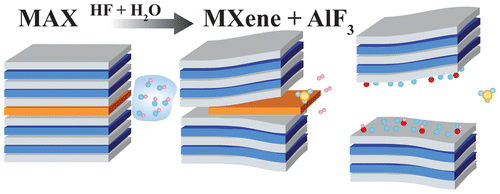Mechanistic Insight into the Chemical Exfoliation and Functionalization of Ti3C2 MXene
슈퍼관리자
2021-05-21
Mechanistic Insight into the Chemical Exfoliation and Functionalization of Ti3C2 MXene
-
Authors :
Pooja Srivastava, Avanish Mishra, Hiroshi Mizuseki, Kwang-Ryeol Lee, Abhishek Singh
-
Journal :
ACS Appl. Mater. & Interface
-
Vol :
8
-
Page :
24256-24264
-
Year :
2016

Abstract
MXene, a two-dimensional layer of transition metal carbides/nitrides, showed great promise for energy storage, sensing, and electronic applications. MXene are chemically exfoliated from the bulk MAX phase; however, mechanistic understanding of exfoliation and subsequent functionalization of these technologically important materials is still lacking. Here, using density-functional theory we show that exfoliation of Ti3C2 MXene proceeds via HF insertion through edges of Ti3AlC2 MAX phase. Spontaneous dissociation of HF and subsequent termination of edge Ti atoms by H/F weakens Al–MXene bonds. Consequent opening of the interlayer gap allows further insertion of HF that leads to the formation of AlF3 and H2, which eventually come out of the MAX, leaving fluorinated MXene behind. Density of state and electron localization function shows robust binding between F/OH and Ti, which makes it very difficult to obtain controlled functionalized or pristine MXene. Analysis of the calculated Gibbs free energy (ΔG) shows fully fluorinated MXene to be lowest in energy, whereas the formation of pristine MXene is thermodynamically least favorable. In the presence of water, mixed functionalized Ti3C2Fx(OH)1–x (x ranges from 0 to 1) MXene can be obtained. The ΔG values for the mixed functionalized MXenes are very close in energy, indicating the random and nonuniform functionalization of MXene. The microscopic understanding gained here unveils the challenges in exfoliation and controlling the functionalization of MXene, which is essential for its practical application.















